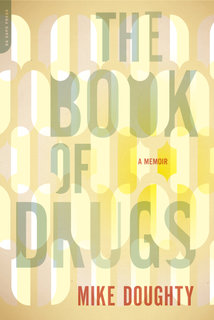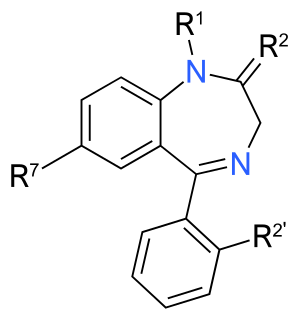 W
WAbstinence is a self-enforced restraint from indulging in bodily activities that are widely experienced as giving pleasure. Most frequently, the term refers to sexual abstinence, or abstinence from alcohol, drugs, or food.
 W
WAcamprosate, sold under the brand name Campral, is a medication used along with counselling to treat alcohol dependence.
 W
WAlcohol withdrawal syndrome (AWS) is a set of symptoms that can occur following a reduction in alcohol use after a period of excessive use. Symptoms typically include anxiety, shakiness, sweating, vomiting, fast heart rate, and a mild fever. More severe symptoms may include seizures, seeing or hearing things that others do not, and delirium tremens (DTs). Symptoms typically begin around six hours following the last drink, are worst at 24 to 72 hours, and improve by seven days.
 W
WThe Alcoholics is a 1953 novel by Jim Thompson.
 W
WAticaprant is a selective antagonist of the κ-opioid receptor (KOR) which was originally developed by Eli Lilly and is now under development by Janssen Pharmaceuticals for the treatment of major depressive disorder and smoking withdrawal.
 W
WDr. Kiran Bedi is an Indian politician, retired IPS Officer, social activist and former tennis player, who is the incumbent Lieutenant Governor of Puducherry. She is the first female Indian Police Service officer and started her service in 1972. She remained in service for 35 years before taking voluntary retirement in 2007 as Director General, Bureau of Police Research and Development.
 W
WThe Book of Drugs is a 2012 memoir by the musician and songwriter Mike Doughty. The book details Doughty's struggles with drug addiction, his musical career, both before and during his time with the band Soul Coughing and during his solo career.
 W
WBuprenorphine is an opioid used to treat opioid use disorder, acute pain, and chronic pain. It can be used under the tongue, in the cheek, by injection, as a skin patch, or as an implant. For opioid use disorder, it is typically started when withdrawal symptoms have begun and for the first two days of treatment under direct observation of a health care provider. The combination formulation of buprenorphine/naloxone (Suboxone) is recommended to discourage misuse by injection. Maximum pain relief is generally within an hour with effects up to 24 hours.
 W
WCetadiol, also known as androst-5-ene-3β,16α-diol, is a drug described as a "steroid tranquilizer" which was briefly investigated as a treatment for alcoholism in the 1950s. It is an androstane steroid and analogue of 5-androstenediol (androst-5-ene-3β,17β-diol) and 16α-hydroxy-DHEA (androst-5-ene-3β,16α-diol-17-one), but showed no androgenic or myotrophic activity in animal bioassays. The drug was reported in 1956 and studied until 1958.
 W
W"Cold turkey" refers to the abrupt cessation of a substance dependence and the resulting unpleasant experience, as opposed to gradually easing the process through reduction over time or by using replacement medication.
 W
WDrug Abuse Resistance Education (D.A.R.E.) is an education program that seeks to prevent use of controlled drugs, membership in gangs, and violent behavior. It was founded in Los Angeles in 1983 as a joint initiative of then-LAPD chief Daryl Gates and the Los Angeles Unified School District as a demand-side drug control strategy of the American War on Drugs.
 W
WDrug addiction recovery groups are voluntary associations of people who share a common desire to overcome drug addiction. Different groups use different methods, ranging from completely secular to explicitly spiritual. Some programs may advocate a reduction in the use of illegal drugs rather than outright abstention, although this is typically not a sustainable treatment plan in the long term. One survey of members found active involvement in any addiction recovery group correlates with higher chances of maintaining sobriety. The survey found group participation increased when the individual members' beliefs matched those of their primary support group. Analysis of the survey results found a significant positive correlation between the religiosity of members and their participation in twelve-step addiction recovery groups and SMART Recovery, although the correlation factor was three times smaller for SMART Recovery than for the twelve-step addiction recovery groups. Religiosity was inversely related to participation in Secular Organizations for Sobriety.
 W
WA halfway house is an institute for people with criminal backgrounds or abusive drug use tendencies to learn the necessary skills to re-integrate into society and better support and care for themselves.
 W
WHeroin-assisted treatment (HAT), or diamorphine assisted treatment, refers to the prescribing of semi-synthetic heroin to opiate addicts who do not benefit from or cannot tolerate treatment with one of the established drugs used in opiate replacement therapy like methadone or buprenorphine. For this group of patients, heroin-assisted treatment has proven superior in improving their social and health situation. It has also been shown to save money, as it significantly reduces costs incurred by trials, incarceration, health interventions and delinquency. It has also drastically reduced overdose deaths in the countries utilizing it, as patients take their dose in a controlled, professionally supervised setting, and Narcan (naloxone) is on hand in the case of an accidental overdose. Opiate related overdoses in the U.S. kill around 70,000 people per year.
 W
WHigh Watch Recovery Center is an alcohol and drug addiction recovery center located in Kent, Connecticut. It was the first recovery center in the US founded on the principles of Alcoholics Anonymous (AA).
 W
WIbogaine is a naturally occurring psychoactive substance found in plants in the family Apocynaceae such as Tabernanthe iboga, Voacanga africana, and Tabernaemontana undulata. It is a psychedelic with dissociative properties.
 W
WInsite is the first legal supervised drug injection site in North America, located at 139 East Hastings Street, in the Downtown Eastside (DTES) neighbourhood of Vancouver, British Columbia. The DTES had 4700 chronic drug users in 2000 and has been considered to be the centre of an "injection drug epidemic". The site provides a supervised and health-focused location for injection drug use, primarily heroin. The clinic does not supply any drugs. Medical staff are present to provide addiction treatment, mental health assistance, and first aid in the event of an overdose or wound. In 2017, the site recorded 175,464 visits by 7,301 unique users; 2,151 overdoses occurred with no fatalities, due to intervention by medical staff. The site also offers a free checking service so clients can check their substances for fentanyl and carfentanil. Health Canada has provided $500,000 per year to operate the site, and the BC Ministry of Health contributed $1,200,000 to renovate the site and cover operating costs. Insite also serves as a resource for those seeking to use a harm reduction approach for people who inject drugs around the world. In recent months and years, delegations from a number of countries are on record touring the facility, including various U.S. states, Colombia and Brazil.
 W
WLevomethadone, sold under the brand name L-Polamidon among others, is a synthetic opioid analgesic and antitussive which is marketed in Europe and is used for pain management and in opioid maintenance therapy. In addition to being used as a pharmaceutical drug itself, levomethadone is the main therapeutic component of methadone.
 W
WThe effects of long-term benzodiazepine use include drug dependence and neurotoxicity as well as the possibility of adverse effects on cognitive function, physical health, and mental health. Long term use is sometimes described as use not shorter than three months. Benzodiazepines are generally effective when used therapeutically in the short term, but even then the risk of dependency can be significantly high. There are significant physical, mental and social risks associated with the long-term use of benzodiazepines. Although anxiety can temporarily increase as a withdrawal symptom, there is evidence that a reduction or withdrawal from benzodiazepines can lead in the long run to a reduction of anxiety symptoms. Due to these increasing physical and mental symptoms from long-term use of benzodiazepines, slow withdrawal is recommended for long-term users. Not everyone, however, experiences problems with long-term use.
 W
WMethadone, sold under the brand names Dolophine and Methadose among others, is an opioid used for opioid maintenance therapy in opioid dependence and for chronic pain management. Detoxification using methadone can be accomplished in less than a month, or it may be done gradually over as long as six months. While a single dose has a rapid effect, maximum effect can take up to five days of use. The pain-relieving effects last about six hours after a single dose. After long-term use, in people with normal liver function, effects last 8 to 36 hours. Methadone is usually taken by mouth and rarely by injection into a muscle or vein.
 W
WMethadone intermediate is a methadone precursor scheduled by UN Single Convention on Narcotic Drugs. It is a Schedule II Narcotic controlled substance in the United States and has an ACSCN of 9254. The 2014 annual manufacturing quota was 32 875 kilos.
 W
W18-Methoxycoronaridine (18-MC) is a derivative of ibogaine invented in 1996 by the research team around the pharmacologist Stanley D. Glick from the Albany Medical College and the chemist Martin E. Kuehne from the University of Vermont. In animal studies it has proved to be effective at reducing self-administration of morphine, cocaine, methamphetamine, nicotine and sucrose. 18-MC is a α3β4 nicotinic antagonist and, in contrast to ibogaine, has no affinity at the α4β2 subtype nor at NMDA-channels nor at the serotonin transporter, and has significantly reduced affinity for sodium channels and for the σ receptor, but retains modest affinity for μ-opioid receptors where it acts as an agonist, and κ-opioid receptors. The sites of action in the brain include the medial habenula, interpeduncular nucleus, dorsolateral tegmentum and basolateral amygdala. It has also been shown to produce anorectic effects in obese rats, most likely due to the same actions on the reward system which underlie its anti-addictive effects against drug addiction.
 W
W(–)-2-Methoxyethyl-18-methoxycoronaridinate (ME-18-MC) is a second generation synthetic derivative of ibogaine developed by the research team led by the pharmacologist Stanley D. Glick from the Albany Medical College and the chemist Martin E. Kuehne from the University of Vermont. In animal studies it has shown similar efficacy to the related compound 18-methoxycoronaridine (18-MC) at reducing self-administration of morphine and methamphetamine but with higher potency by weight, showing anti-addictive effects at the equivalent of half the minimum effective dose of 18-MC. Similarly to 18-MC itself, ME-18-MC acts primarily as a selective α3β4 nicotinic acetylcholine antagonist, although it has a slightly stronger effect than 18-MC as an NMDA antagonist, and its effects on opioid receptors are weaker than those of 18-MC at all except the kappa opioid receptor, at which it has slightly higher affinity than 18-MC.
 W
W(–)-18-Methylaminocoronaridine (18-MAC) is a second generation synthetic derivative of ibogaine developed by the research team led by the pharmacologist Stanley D. Glick from the Albany Medical College and the chemist Martin E. Kuehne from the University of Vermont.
 W
WThe Poppy Is Also a Flower is a 1966 American-French-Austrian made-for-television spy and anti-drug film. It was originally made under the auspices of the United Nations as part of a series of television specials designed to promote the organization's work. The film was directed by Terence Young and stars Yul Brynner, Omar Sharif, Eli Wallach, Angie Dickinson, Senta Berger, Stephen Boyd, Trevor Howard, Rita Hayworth and Marcello Mastroianni. Grace Kelly narrates.
 W
WShanthi Ranganathan is an Indian social worker and the founder of T. T. Ranganathan Clinical Research Foundation, a non governmental organization managing the TTK Hospital, a medical centre based in Chennai for the treatment and rehabilitation of drug and alcohol addicts. She is the first recipient of the UN Vienna Civil Society Award and a recipient of the 1992 Padma Shri, the fourth highest civilian award from the Government of India for her contributions to the society.
 W
WSmoking cessation is the process of discontinuing tobacco smoking. Tobacco smoke contains nicotine, which is addictive and can cause dependence. Nicotine withdrawal often makes the process of quitting difficult.
 W
WSobriety is the condition of not having any measurable levels or effects from alcohol or other drugs. Sobriety is also considered to be the natural state of a human being given at a birth. A person in a state of sobriety is considered sober. Organizations of the temperance movement have encouraged sobriety as being normative in society. In a treatment setting, sobriety is the achieved goal of independence from consuming alcohol. As such, sustained abstinence is a prerequisite for sobriety. Early in abstinence, residual effects of alcohol consumption can preclude sobriety. These effects are labeled "PAWS," or "post acute withdrawal syndrome." Someone who abstains, but has a latent desire to resume use, is not considered truly sober. An abstainer may be subconsciously motivated to resume alcohol consumption, but for a variety of reasons, abstains. Sobriety has more specific meanings within specific contexts, such as the culture of many substance use recovery programs, law enforcement, and some schools of psychology. In some cases, sobriety implies achieving "life balance."
 W
WThienorphine is a very potent, extremely long-acting, orally-active opioid analgesic with mixed agonist–antagonist properties which was developed by the Beijing Institute of Pharmacology and Toxicology as a potential treatment for opioid dependence. It is a high-affinity, balanced ligand of the μ-, δ-, and κ-opioid receptors, behaving as a partial agonist of the μ- and κ-opioid receptors and as an antagonist of the δ-opioid receptor. It also possesses relatively low affinity for the nociceptin receptor, where it acts as an antagonist.
 W
WThe three circles is an exercise / diagram used by recovering addicts to describe and define behaviors that lead either to a relapse into or recovery from addictive behaviors. Some treatment groups and 12-step recovery programs encourage recovering addicts to complete the three circle exercise to help the addict identify behaviors that promote or endanger their sobriety. The first use of the term is found in a pamphlet publication of Sex Addicts Anonymous, entitled "Three circles: Defining sobriety in S.A.A." Minneapolis, MN: SAA Literature (1991). It has since been republished.
 W
WVoacangine is an alkaloid found predominantly in the rootbark of the Voacanga africana tree, as well as in other plants such as Tabernanthe iboga, Tabernaemontana africana, Trachelospermum jasminoides, Tabernaemontana_divaricata and Ervatamia yunnanensis. It is an iboga alkaloid which commonly serves as a precursor for the semi-synthesis of ibogaine. It has also been demonstrated in animals to have similar anti-addictive properties to ibogaine itself. It also potentiated effects of barbiturates
 W
WThe Washingtonian movement was a 19th-century temperance fellowship founded on Thursday, April 2, 1840 by six alcoholics at Chase's Tavern on Liberty Street in Baltimore, Maryland. The idea was that by relying on each other, sharing their alcoholic experiences and creating an atmosphere of conviviality, they could keep each other sober. Total abstinence from alcohol (teetotalism) was their goal. The group taught sobriety and preceded Alcoholics Anonymous by almost a century. Members sought out other "drunkards", told them their experiences with alcohol abuse and how the Society had helped them achieve sobriety. With the passage of time the Society became a prohibitionist organization in that it promoted the legal and mandatory prohibition of alcoholic beverages. The Society was the inspiration for Timothy Shay Arthur's Six Nights with the Washingtonians and his Ten Nights in a Bar-Room.